Managing the Project Scope - Free eBook in PDF Format
 |
 |
|
Book Description - ISBN 978-1-62620-980-7 (48 Pages)
This free eBook explains the processes and requirements involved in scope management. Any planning or work activity which is not directly focused on completing the specified project objective represents a waste of resources and should not be undertaken. Many projects fail because of difficulties in trying to control the scope of the project.
Chapter 1 - Managing the Project Scope
This area includes the processes required to ensure that the project includes all the work, and only the work required to complete the project successfully. It is primarily concerned with controlling what is and what is not included the scope.
Chapter 2 - Scope Creep and Project Change Control
As well as defining the scope of the project in the planning stage it is also necessary to actively manage it. This is because there are two groups of stakeholders that will almost invariably apply pressure to change the scope of the project throughout its life cycle.
Chapter 3 - How to Manage the Project Scope
This process involves creating a scope plan that describes how the scope of the project will be defined, validated and controlled so that it can be managed throughout the life of the project. The main input to this process is the project charter, and by using expert judgment in conjunction with project team meetings, two key documents will be produced, the scope plan and the requirements plan.
Chapter 4 - Documenting the Project Requirements
This process is concerned with assessing, documenting, and managing stakeholder needs to meet project objectives. All requirements should be gathered at the start because as the project progresses changes then become increasingly costly. Gathering requirements from all stakeholders will also ensure that their opinions are taken into consideration, which will lead to higher rates of project acceptance.
Chapter 5 - Creating a Project Scope Statement
This process involves creating a detailed description of the project and it's deliverables using the scope plan, the requirements documentation and project charter (created in the process of initiating the project). It takes the high-level product descriptions, assumptions and constraints documented in the project charter and creating a 'scope statement' which has a more detailed description of these items.
Chapter 6 - Creating a Work Breakdown Structure
The creation of the work breakdown structure (WBS) should be one of the first steps in the planning process, once the requirements specification for the project has been written. It should reflect the way the work will be performed and the way in which project costs and data will be summarized and reported.
Chapter 7 - Validating and Controlling the Scope
This process involves taking the deliverables which have been internally checked to see whether they meet the customer's requirements, and then actually present them to the customer for formal acceptance. It confirms that the work being considered matches the details in the work breakdown structure, scope plan and project plan. This is done using reviews or audits and user trials creating the scope baseline. Controlling the scope is the process of managing any changes requested to this project baseline. There will inevitably be changes to this but it is important to ensure that these changes do not build upon each other incrementally. This is something referred to as scope creep and always produces unacceptable risks because the combined effects of these incremental changes are seldom considered in total.
| You will learn: |
|
![]()
![]()
Background
Every business or organization exists for a specific purpose. While most are intended to make money, there are usually more defined goals under that general umbrella. For example, your business might be designed to sell a specific product or service, or even just provide information on a given topic. Whatever it is that your organization is meant to do, it is critical that it does that job to the highest possible level.
On a smaller scale, it is the same way with projects. Projects exist within organizations, and they are intended to accomplish a specific purpose as well. However, instead of 'selling a certain product', a project might be created to design a new feature that will be included with that product or service next year. This is, of course, just one of an infinite number of possible examples.
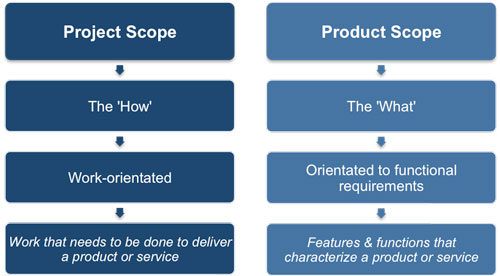 |
No matter what a project is designed to do, it is crucial that it be defined and established as accurately as possible ahead of time. This is often called the 'scope' of the project. Scope management is a knowledge area that is focused on making sure that a given project includes everything that it needs to complete the task as described, and nothing more. If a project doesn't have all of the necessary resources available to it, the project isn't likely to be finished because it will be ill-prepared for the challenges ahead. At the same time, if the project has more than it needs, the outcome may be reached but resources will have been wasted along the way.
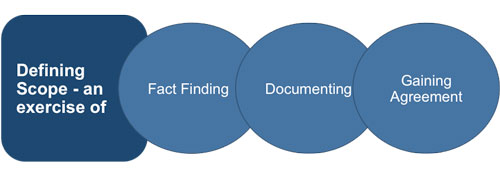 |
Getting the scope just right on a project is one of the most-important elements of achieving success in the end. Only when the scope is dialed in correctly can everything else in the project be completed according to plan.
The resources dedicated to a project can take on many forms, but all of them are important. The scope of a project takes a view of these resources as a whole to determine if the project has just what is needed to reach the goal that has been laid out. Firstly, project requirements must be collected and defined so that a work breakdown structure (WBS) document can be created. This can be defined as:
A deliverable-orientated hierarchical decomposition of the work to be executed by the project team to accomplish the project objectives and create the required deliverables.
Some examples of the resources that a project can use would include -
Employees - this is probably the first resource that is considered when putting together a new project. Who is going to work on these tasks? Do these people exist within the organization, or will new team members need to be retained? Do current employees have the time available to work on this project specifically? All of these questions and more need to be answered when assembling a project team. Getting the team right is a major factor of properly 'scoping' a project.
Budget - most projects include some kind of capital budget for expenses that go beyond things like payroll. Using our example from earlier regarding a new feature to add to a product, there may be some cost associated with buying materials that will go into that new feature. Budgeting for things like raw materials and new equipment also goes toward the overall scope of the project.
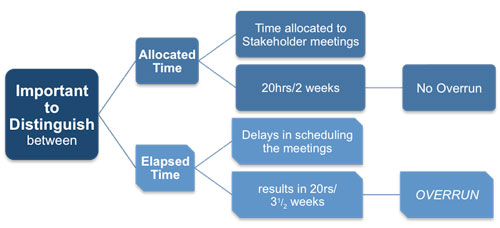 |
Time - as they say, time is money in business. The longer a project takes to be completed, the more it will cost the organization. When a project is first being designed, there should be a time line in place that defines the scope of the work in that regard. For example, the project could be planned to take only a month, or it could be scheduled for a year or more. Since time and money are so closely connected, predicting the time scope of the project accurately is important when it comes to controlling costs.
Goal - one other important piece of project scope is simply what the goal of the project is in the first place. This can often become lost in the shuffle as the project develops, and the final result may end up well outside of the scope that was originally intended. Using that example one more time from above, instead of designing a new feature for an existing product, the team could end up with a whole new product entirely. While that could be a good or bad thing, it is certainly outside of the originally scope of the project.
The four items above are usually the main components that need to be considered when framing the scope of an upcoming project.
 |
Project managers are not only tasked with getting to the end of a project successfully, but also with making sure that what happens during the project is within the scope that was laid out for them at the beginning.
The Concept of Creep
The idea of scope creep is one that has plenty of uses in business, and it applies in project management as well. While trying to keep a project within its original scope, you might find that 'project creep' starts to develop and things grow quickly out of control.
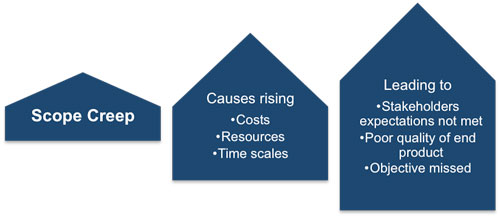 |
This happens when one part of the project spurs an idea to do something else, or to add onto what is already being done. The project creeps larger and larger until it isn't anything like what it was supposed to be in the beginning. Preventing project creep is a task that the project manager and other leaders should take seriously. It creep is left unchecked over a period of time, the overall project could end up being far more costly and time consuming than expected.
Being a business leader in general is largely about understanding and managing scope. The best companies in the world know exactly what they do best, and they stick to it as closely as possible. Many businesses have been undone by straying from their core competency and trying to do too much, too quickly. Don't let that happen to a project that you are managing.
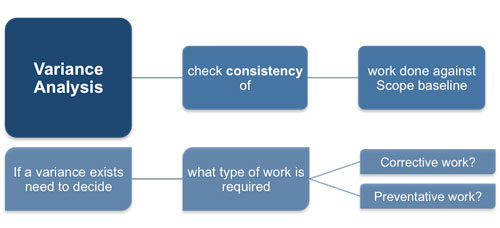 |
Laying out a defined scope at the beginning of the work, and then sticking with it as much as possible throughout the project life-cycle, is the path toward a successful conclusion and overall improvement for the organization.


